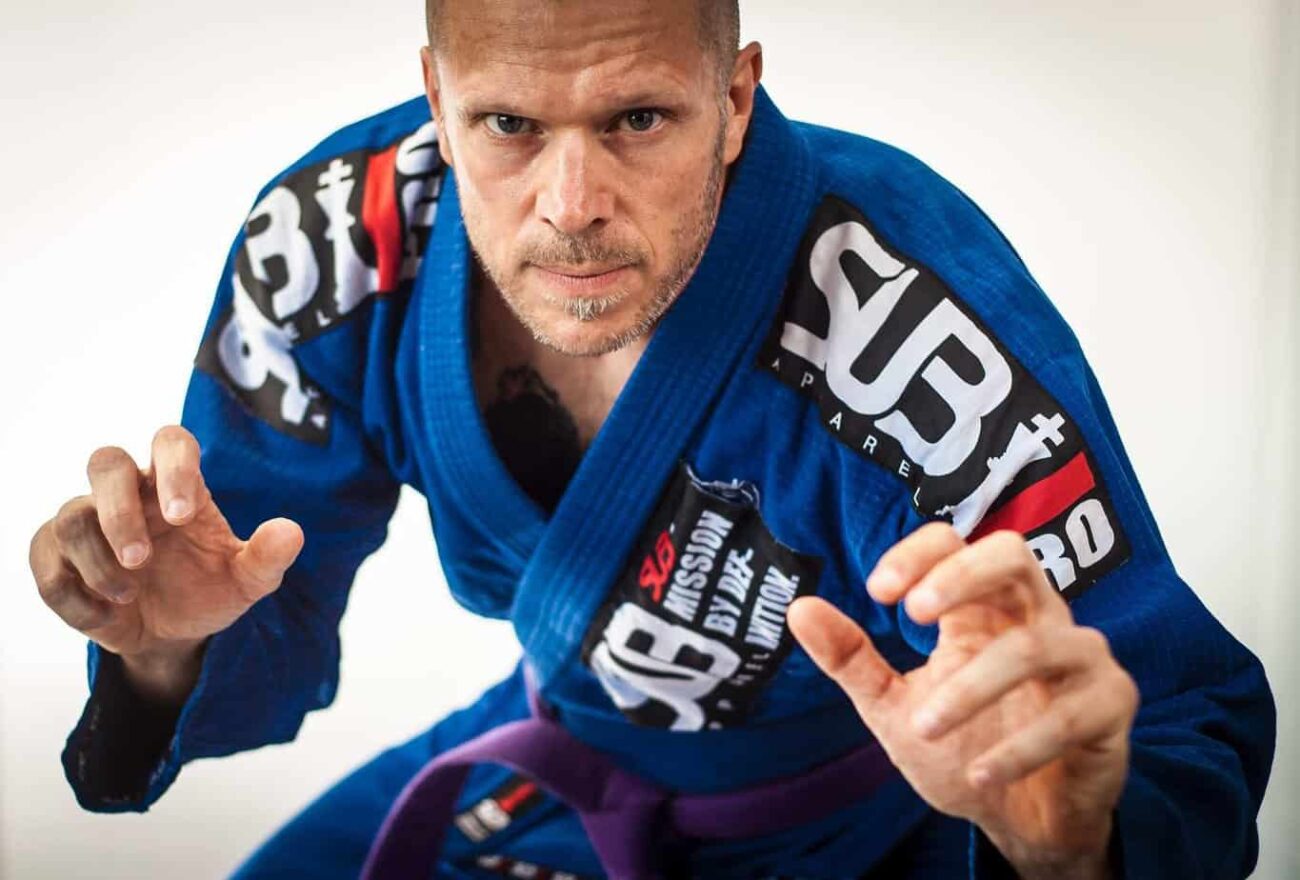By | 11 minutes of reading | January 14, 2024
We’ve already discussed the ranking systems of many other martial arts and now it’s time we analyze the system in Brazilian jiu-jitsu, one of the most popular sports in modern MMA. Brazilian jiu-jitsu is a relatively new martial art compared to some Oriental arts, and it is a rare example of martial art that stems from South America rather than Asia; you know that most combat sports stem from the West, while the East is known for its martial arts.
As you are going to see, Brazilian jiu-jitsu is quite different than the majority of Oriental martial arts when it comes to belts and rankings, which merits this analysis. So, how many belts are there in BJJ? Is there a different Jitsu belt system between dojos and federations? If you want to see how different it is – continue reading.
Your BJJ journey starts with mastering the ranking system of the sport. But To complement your hard work in practice, equip yourself with the best BJJ gi in the market, and stand out on the mats. With their exceptional features, you can focus on building your skills and dominating your opponents – exactly what every fighter in BJJ aims for.
In this Article hide
History of Belts in Martial Arts
Two Different Belt Systems in Brazilian Jiu-Jitsu
Youth (Junior) Belts in Brazilian Jiu-Jitsu
Adult Belts in Brazilian Jiu-Jitsu
History of Belts in Martial Arts
Before we focus on Brazilian jiu-jitsu, we’ll briefly recapitulate the history of belts in modern martial arts. As we know, Oriental martial arts have been practiced in the Far East for centuries, but the belt system is a relatively new phenomenon, just a little over a century old. Before belts were introduced, martial artists handed out certificates (or diplomas) to students who had reached a certain level of knowledge and ability.
But, at the turn of the 20th century, a man called Jigorō Kanō, best known as the founder of judo, decided to introduce colored belts in his art. This was not a completely original idea, as he was inspired by a similar system present in the Japanese board game of go (similar to chess), but it was a revolution in the world of martial arts.
The essential idea behind the belt system was to enable students to advance more rapidly, but also to enable fighters to quickly identify the level of knowledge their opponent has, thus leading to a more leveled field in potential combat.
There are belts in many other fighting styles, too, and Kanō’s original colors were blue, white, brown, and black, but as the years passed, the system became more sophisticated and included a larger palette of colors.
As for Brazilian jiu-jitsu, it’s generally presumed that the first belt system was introduced in 1967 in Rio de Janeiro, from where it spread to other schools and federations. Before that, Brazilian jiu-jitsu had a rudimentary belt system consisting of three colors – white for beginners, light blue for instructors, and dark blue for masters.
Since 1967, BJJ has used a more sophisticated system that can be divided into junior and senior belts, so we’ll analyze each of them in the following paragraphs.
Two Different Belt Systems in Brazilian Jiu-Jitsu
We have seen that most martial arts don’t have a fully unified ranking system. There is always a general guideline, but some schools can alter it slightly and adapt it to their teaching. Brazilian jiu-jitsu is not an exception, as it has two competing systems.
One system is the Gracie system, founded by Carlos and Hélio Gracie and used by the Gracie family, and the International Brazilian Jiu-Jitsu Federation (IBJJF) system, prescribed by the international governing body of Brazilian jiu-jitsu.
The two systems are similar, but there are some important differences, mostly in junior belts, which we will present to you in the following paragraphs.
Youth (Junior) Belts in Brazilian Jiu-Jitsu
Children between ages 4 and 15 can receive belt colours that reward progress after a white belt but before earning a blue belt, which can only be awarded to students that are 16 or older. In 2015, International Brazilian Jiu-Jitsu Federation specified 13 belts for competitors aged 4 through 15.
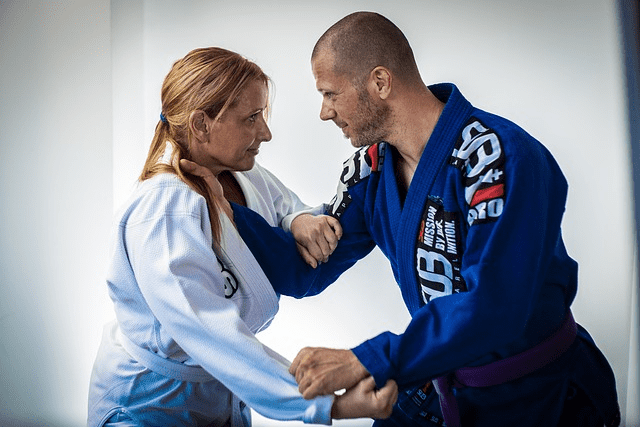
Brazilian Jiu-Jitsu Belts: Ranking System Explained
The group of three grey belts is for competitors aged 4 through 15 years old. The group of three yellow belts is for competitors 7 through 15 years old. The group of orange belts is for competitors 10 through 15 years old. The group of three green belts is for competitors 13 through 15 years old.
The Gracie system uses a different color system. Namely, in the 1990s, Brazilian judo clubs began awarding grey belts for children advancing from white belts. In the same interest of providing children with the more frequent rank promotion within Gracie jiu-jitsu, Pedro Valente Sr. and his sons proposed an adaptation to the youth belt system. It involved intermediate belts consisting of half-colors, awarded between full-colored belts.
Each half-color promotion includes a color previously attained, and the next full-color rank. This change provided a full ten belts (as opposed to the previous system of only four), allowing instructors to award children more frequently, and increase motivation among young students. The new system was approved in 2005, and he added that it was the most efficient and simple way to give children self-confidence.
Each rank has a recommended maximum age, beginning with the white/yellow belt at age 5 and under. Each subsequent belt has the recommendation for each subsequent year of age, ending with the green belt at age 13 and below.
Under this schedule of promotion, a junior student would receive a stripe roughly every three months, and a new belt after each year of training until the age of 13. After the green, the next belt rank is a blue belt, which has a required minimum age of 16 years Although typical, a student doesn’t need to go through each rank individually.
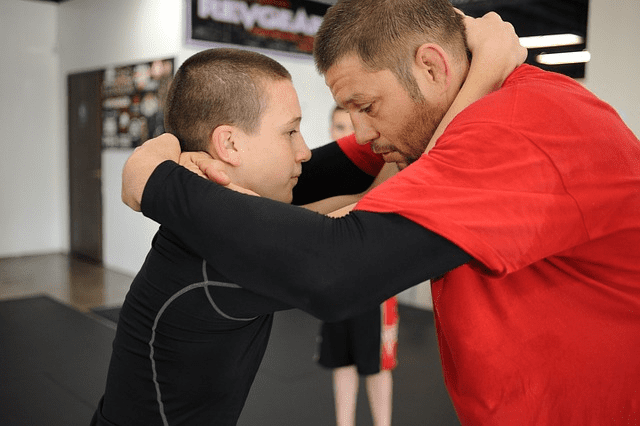
Brazilian Jiu-Jitsu Belts: Ranking System Explained
IBJJF Youth Rankings
Now, let us see the belts as prescribed by the IBJJF. I will analyze the BJJ belt system step by step so you can understand it easily, but remember this – there are no variations of white belts, it comes later:
- White belt;
- Gray-white belt;
- Gray belt;
- Gray-black belt;
- Yellow-white belt;
- Yellow belt;
- Yellow-black belt;
- Orange-white belt;
- Orange belt;
- Orange-black belt;
- Green-white belt;
- Green belt;
- Green-black belt.
Gracie BJJ Kids’ Rankings
The Gracie Brazilian jiu jitsu belt ranking looks like this (kids BJJ belts):
- White belt;
- White-yellow belt rank;
- Yellow belt;
- Orange-white belts;
- Orange-yellow belt;
- Orange belt;
- Green-white belt;
- Green-yellow belt;
- Green-orange belt;
- Green BJJ belt at the end.
Because there is a different number of belts in the two systems, IBJJF (Brazilian jiu jitsu federation) created a scale to compare and equalize the ranks in these two systems. BJJ belt systems look like this, take a close look at this drawing for a better understanding of the same belt levels and differences between the two schools:

Brazilian Jiu-Jitsu Belts: Ranking System Explained
Source: ibjff.com
When a competitor turns 16, he must move to the adult system of belts according to the belt that he has at the time. White belts remain at white belts. Gray, yellow, or orange belts can turn into white or blue belts at the professor’s decision. The green jiu jitsu belt can turn into a white, blue, or even purple belts according to the professor’s decision.

Brazilian Jiu-Jitsu Belts: Ranking System Explained
Adult Belts in Brazilian Jiu-Jitsu
The adult belts colorers are the same in both systems, so we can analyze them both simultaneously; there are some differences in the requirements, but you’ll see that as we continue our analysis.
The system is a bit different compared to any other martial art, so you’ll have to pay special attention. The colors are:
White belt
White belt is the beginning rank for all Brazilian jiu-jitsu students, there is no white belt minimum age, and it is the earliest stage on the scale of BJJ belts. The rank is held by any practitioner new to the art and has no prerequisite. Some instructors and other high-level practitioners think that a white belt’s training should emphasize escapes and defensive positioning since a white belt will often fight from inferior positions, especially when training with more experienced practitioners. Most academics will additionally require that a white belt level practitioner works to obtain a well-rounded skill set, with a knowledge of basic offensive moves, such as common submissions and guard passes.
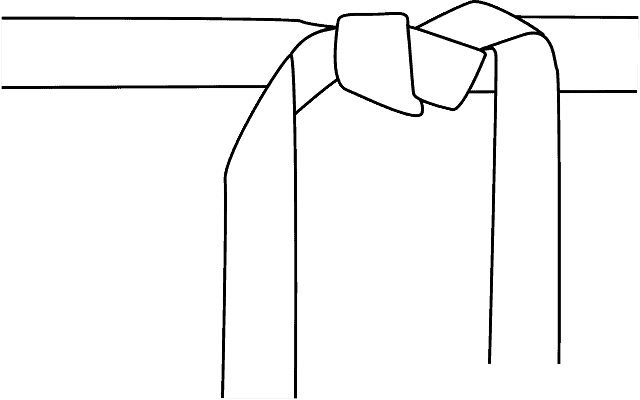
Brazilian Jiu Jitsu Belts Ranking System Explained
Blue belt
Blue belt is the second adult rank in Brazilian jiu-jitsu at schools that do not use yellow, orange, and green belts for adults. At the blue belt level, students gain a wide breadth of technical knowledge and undertake hundreds of hours of mat time to learn how to implement these moves efficiently. Blue belt is often the rank at which the student learns a large number of techniques. The IBJJF requires a practitioner remain a blue belt for a minimum of two years before progressing to purple. Although many Brazilian jiu-jitsu organizations adhere to the IBJJF standard of awarding the yellow, orange, and green jiu jitsu belt exclusively as part of a youth belt system (under 16 years of age), some supplement the time between white belt and blue belt with one or more belts of these colors with adult practitioners as well. The IBJJF requires that a practitioner be at least 16 years old to receive a blue belt, thereby officially entering into the adult belt system.
Purple belt
Purple belt is the intermediate adult ranking in Brazilian jiu-jitsu. The purple belt level practitioner has gained a large amount of knowledge, and purple belts are generally considered qualified to help instruct lower-ranked students. The IBJJF requires students to be at least 16 years old and recommends they have spent a minimum of two years ranked as a blue belt to be eligible to submit purple belts, with slightly different requirements for those graduating directly from the youth belts. Technically, the purple belt minimum age is 16, but it could vary from dojo to dojo. The IBJJF requires a practitioner remain a purple belt for a minimum of 18 months before achieving a brown belt.
Brown belts
Brown belt is the highest-ranking color belt below the black belt in Brazilian jiu-jitsu. Progressing from a beginner white belt to a brown belt typically requires at least five years of dedicated training. It is often thought of as a time for refining techniques. The IBJJF requires that students be at least 18 years old and recommends they have spent a minimum of 18 months as a purple belt to be eligible for a brown belt. The IBJJF requires a practitioner to train at the brown belt level for a minimum of one year before ascending to the black belt.
Black belt
In Brazilian jiu-jitsu, the black belt denotes an expert level of technical and practical skill. BJJ black belts are often addressed within the art as “professor”, although some schools and organizations reserve this title for more senior black belts. To be eligible for a black belt, the IBJJF requires that a student be at least 19 years old and have spent a minimum of a year as a brown belt. The black belt itself has nine different degrees of expertise, with rankings at seventh degree and eighth degree black belt commonly denoted by a coral belt, and the ninth degree represented by a red belt. The IBJJF requires a practitioner to practice and teach at the black belt level for a minimum of three years before progressing to the next rank. As with most things in jiu-jitsu, there is no standardization from one academy or organization to another. This is also true for the black belt, as there is no set guidance from the IBJJF related to variations of the belt. However, there are three common variations of a black belt, each of which has its general meaning: a black belt with a white bar generally indicates a competitor or practitioner, while a black belt with a plain red bar is the standard black belt (but sometimes differentiates a coach from a professor), and a red bar with white borders on both ends sometimes comes after at least a year or more of teaching as a black belt and can differentiate a professor.
Red and black belt in BJJ belt system
When a Brazilian jiu-jitsu black belt reaches the seventh degree, he or she is awarded an alternating red-and-black belt. This belt is commonly known as a coral belt, after the coral snake. Coral belts are very experienced practitioners, most of whom have made a large impact on Brazilian jiu-jitsu, and are often addressed within the art by the title master. The IBJJF requires a minimum of 7 years of training and teaching at the black and red belt level before progressing to the next rank.
Red and White Belt
A practitioner who has achieved the rank of 8th-degree black belt will wear a red and white belt, which is also commonly called a coral belt. The IBJJF requires a minimum of 10 years of teaching and training at the red and white belt level before progressing to the next rank.
Red Belt
In Brazilian jiu-jitsu, the red belt is reserved “for those whose influence and fame takes them to the pinnacle of art”. It is awarded instead of a ninth and tenth-degree black belt. If a practitioner receives his or her black belt at 19 years old, the earliest they or could expect to receive a ninth-degree red belt would be at the age of 67. Brazilian jiu-jitsu red belt holders are often addressed within the art by the title grandmaster. The 10th degree was given only to the pioneers of Brazilian Jiu-Jitsu, and the Gracie brothers: Carlos, Oswaldo, George, Gaston, and Hélio. The 9th-degree red belt is the highest rank awarded to any currently living practitioner of Brazilian jiu-jitsu. So, technically, the red belt minimum age is 67… how impressive is that?!
Unique Gracie System Belts
In some instances, practitioners within the Gracie system will wear belts not recognized or utilized within the greater jiu-jitsu community.
Some notable black belt level practitioners, including Royce Gracie and the Valente brothers, have transitioned to wearing a dark navy blue belt in deference to the historical tradition before the colored belt ranking system, (a white belt designated a student, a light blue belt designated an instructor, and head professors wore a dark navy belt).
For individuals who begin training as adults (automatically bypassing junior grade levels), the Gracie Jiu-Jitsu Academy and its Certified Training Centres around the world award a white belt with a navy blue center to students who are promoted from the solid white (beginner) rank. So the color of the “current belt” is kinda different for grown adults.
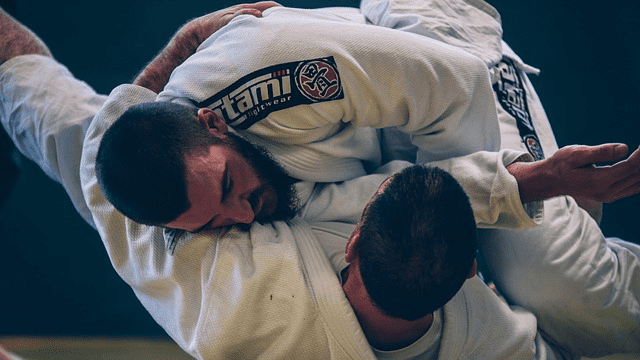
Brazilian Jiu-Jitsu Belts: Ranking System Explained
This belt is referred to as a “Combatives belt” about the Gracie Combatives program which serves as the foundation for all beginner students.
This belt was introduced to serve as an intermediary rank for students who have completed the beginner curriculum, but still lack the level of experience commonly attributed to blue belt practitioners.
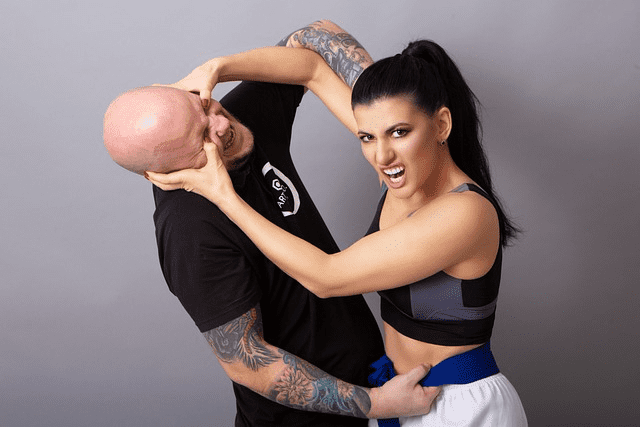
Brazilian Jiu-Jitsu Belts: Ranking System Explained
The Academy also introduced a pink belt for graduates of their Women Empowered self-defense program, a curriculum featuring a limited set of jiu-jitsu techniques specifically curated to defend against common sexual assault scenarios.
The special belts are (color belt):
- Professor;
- Combatives;
- Women’s Self-Defence.
And this is the story of belts and belt colors in Brazilian jiu-jitsu. I hope you enjoyed our newest piece of info and that you’ll be following us for more of the same.
I bet you know the difference between the International Brazilian jiu jitsu and Gracie belt systems now, and your brains are loaded with much new info on the BJJ belt system at the moment!
If you are interested in belts and ranking systems of other martial arts, take a look at the articles we wrote:
